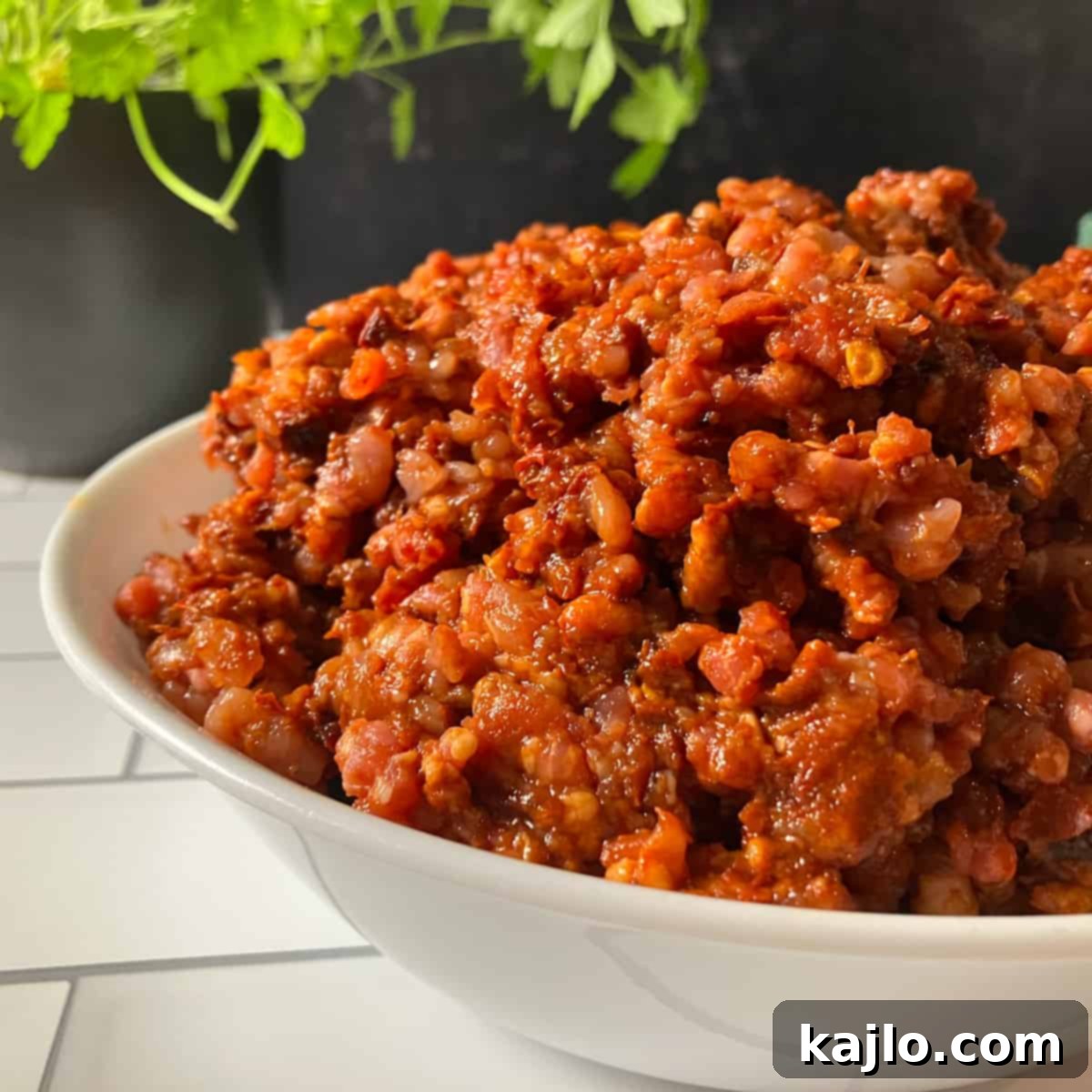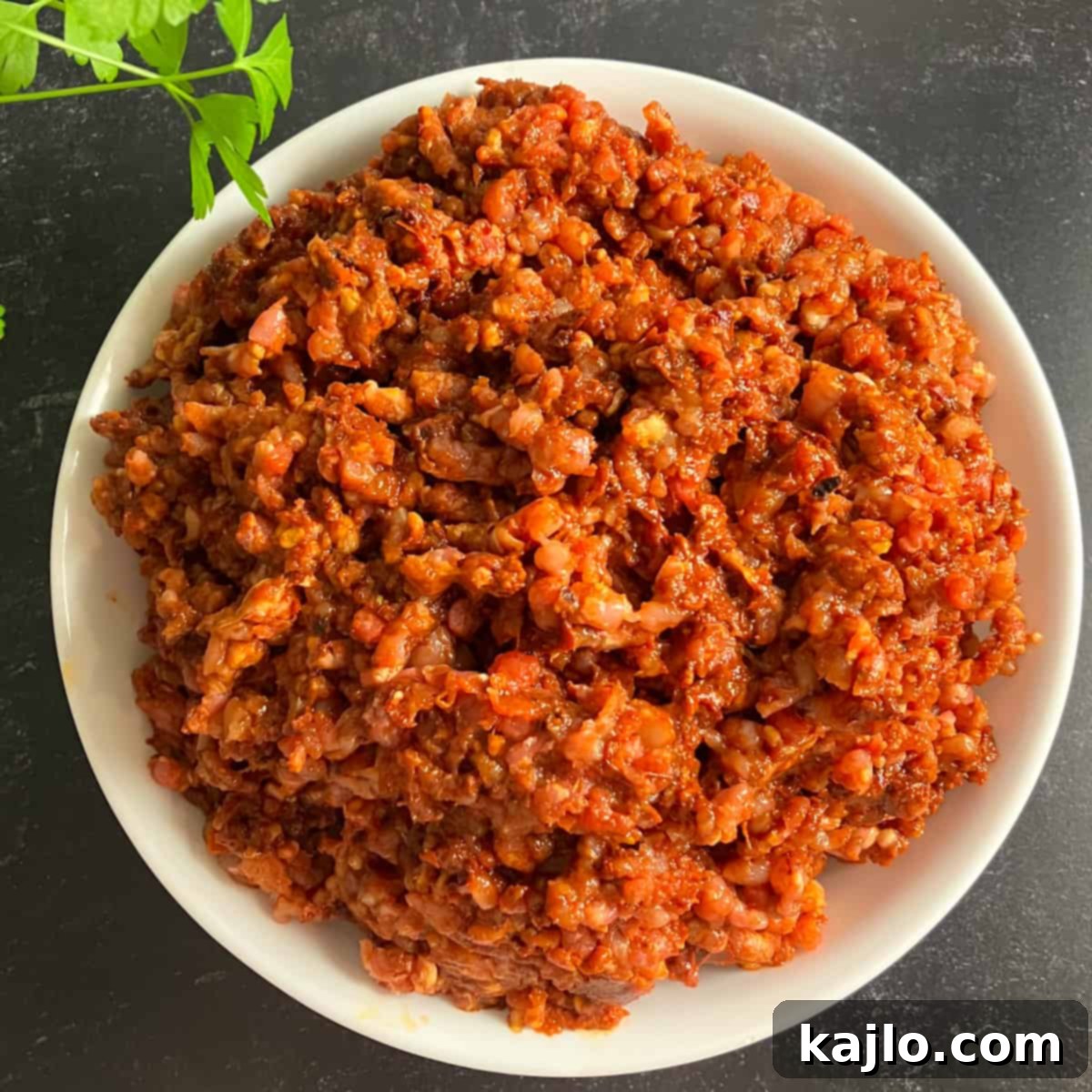Homemade Mexican Chorizo: Craft Your Own Authentic Fresh Sausage
Chorizo is a deeply flavorful, intensely seasoned pork sausage cherished in cuisines around the globe. While many are familiar with its cured and dried forms, today we are delving into the exciting world of fresh Mexican-style chorizo. This particular rendition of chorizo stands out with its vibrant use of dried chile peppers and a distinct tangy kick from vinegar. My special recipe adds a twist by incorporating a balanced blend of half pork and half chicken, aiming for a slightly lighter profile without sacrificing any of that signature rich flavor.
For those of us in regions where authentic fresh Mexican chorizo is a rarity in standard supermarkets, making it from scratch isn’t just a culinary adventure—it’s a necessity. Imagine having a batch of perfectly spiced, homemade chorizo ready in your kitchen, far superior to anything you might find store-bought. It’s a rewarding project that promises unparalleled taste.
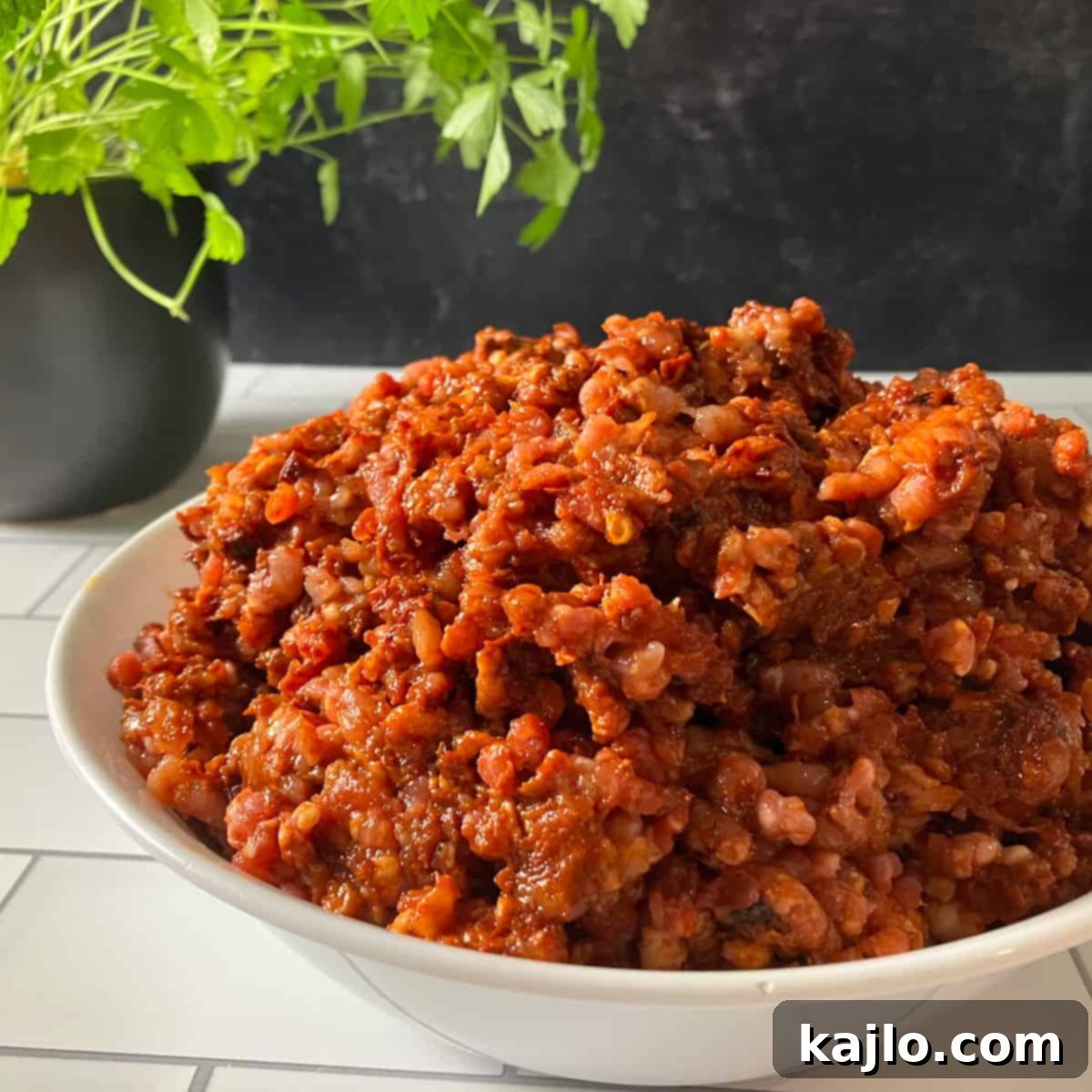
As an avid enthusiast of flavorful meats, chorizo consistently ranks high on my list for creating dishes bursting with character. My personal quest for fresh, high-quality chorizo in the northeastern United States often ends in disappointment at conventional grocery stores. This recurring challenge ultimately inspired me to explore the craft of homemade chorizo, leading to this fantastic recipe I am excited to share.
“Unlocking the true taste of Mexican cuisine, one homemade chorizo batch at a time.”
– MSH
➕ The Unique Essence of Mexican Chorizo
It’s crucial to understand that not all chorizo is created equal. Many people are familiar with Spanish chorizo (or its Portuguese counterpart, chourico), which are typically firm, cured pork sausages. These varieties are often distinguished by their deep red color, primarily derived from smoked paprika, and are designed to be sliced and eaten as charcuterie or added to dishes as a flavorful component that doesn’t require extensive cooking. They offer a dense texture and a pronounced smoky flavor profile.
Mexican-style chorizo, however, is a different beast entirely. It is a fresh, raw sausage that must be cooked thoroughly before consumption. This distinction allows for a softer, more pliable texture and incredible versatility in cooking. The hallmark of Mexican chorizo lies in its bold seasoning, primarily featuring a complex array of chili peppers (or high-quality chili powder) and a crucial acidic component: vinegar. This combination delivers a unique tangy heat and earthy depth that sets it apart. Furthermore, while pork is traditional, Mexican chorizo can be made from a variety of meats, including fatty pork, beef, chicken, or even plant-based alternatives, offering a flexible and inclusive approach to this beloved sausage.
Having recently invested in a meat grinder, I seized the opportunity to finally perfect my own Mexican-style chorizo. The results were truly exceptional, and I’m eager for you to experience the same success with this detailed recipe. Get ready to elevate your cooking! I’m already planning to whip up my favorite chorizo stuffed zucchini boats, a delicious and creative way to utilize this fresh sausage. Beyond that, it’s perfect for classic chorizo and eggs for breakfast, or for infusing your tacos with an explosion of authentic flavor.
🐷 Homemade Mexican Chorizo: Essential Ingredients List
Understanding what goes into chorizo is the first step to crafting a truly magnificent batch. This recipe focuses on fresh, high-quality ingredients that build a robust and authentic flavor. Here’s a detailed breakdown of what you’ll need to make your own Mexican chorizo:
- 2 lbs (907 grams) Pork Butt or Pork Shoulder: These cuts are ideal due to their excellent balance of lean meat and fat, which is essential for juicy and flavorful sausage.
- 2 lbs (907 grams) Boneless and Skinless Chicken Thighs: Including chicken thighs helps to lighten the overall fat content of the sausage, making it a bit leaner while still providing tenderness and absorbing the rich flavors beautifully.
- 2 teaspoons Salt: Crucial for seasoning and drawing out the flavors of the meat and spices.
- 6 Dried Ancho Chiles: These rehydrated poblano peppers contribute a mild, sweet, and fruity undertone with hints of tobacco and raisin, adding complexity without excessive heat.
- 10 Dried Guajillo Chiles: Known for their mild-medium heat, vibrant red color, and a distinctive flavor profile often described as fruity with notes of green tea. They are a cornerstone of many Mexican sauces.
- 2 Dried Japones Chiles: These smaller, hotter chiles introduce a moderate, clean heat that balances the milder ancho and guajillo peppers.
- 6 tablespoons White Vinegar: A vital ingredient that provides the characteristic tanginess of Mexican chorizo and also plays a role in its preservation.
- 7 cloves Garlic, minced: A pungent aromatic that forms the savory backbone of the spice paste.
- 1 tablespoon Dried Oregano: For optimal authenticity, seek out Mexican oregano, which has a distinct citrusy and earthy flavor profile compared to Mediterranean oregano. If not available, regular oregano works.
- 1 tablespoon Ground Cumin: Adds a warm, earthy, and slightly peppery note, contributing to the depth of flavor.
- 1 tablespoon Smoked Paprika: This spice not only contributes to the chorizo’s iconic vibrant red color but also introduces a delicious layer of smokiness.
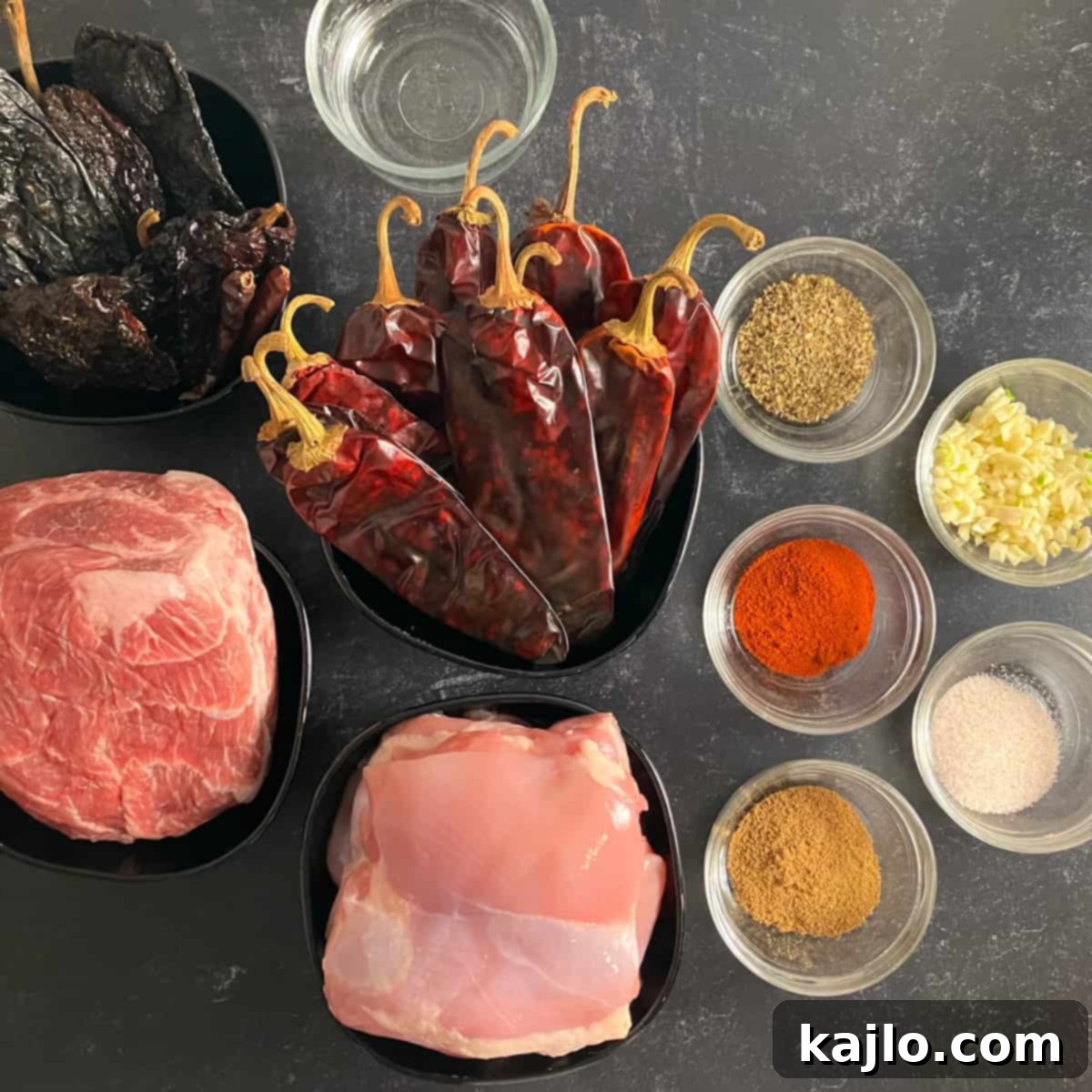
While this recipe provides a robust and authentic flavor, remember that chorizo is a highly customizable sausage. Some cooks enjoy experimenting with additional aromatic spices like a pinch of cinnamon or ground cloves, or even incorporating herbs such as thyme or bay leaves for added complexity. Feel free to use this recipe as a creative launchpad to tailor your chorizo to your exact taste preferences.
What is the Main Ingredient in Chorizo?
The traditional and defining main ingredient in most chorizo varieties is pork, specifically a combination of pork meat and a good amount of pork fat. The fat content is crucial, as it contributes significantly to the sausage’s moist texture, rich flavor, and overall succulence. However, the beauty of chorizo lies in its highly adaptable seasoning profile. This allows for excellent variations, and it’s common to find chorizo made from other meats like beef or chicken (as in this recipe), or even a blend of different meats. For those seeking plant-based options, soy or other vegetable proteins can be expertly spiced to achieve a similar aromatic and flavorful experience.
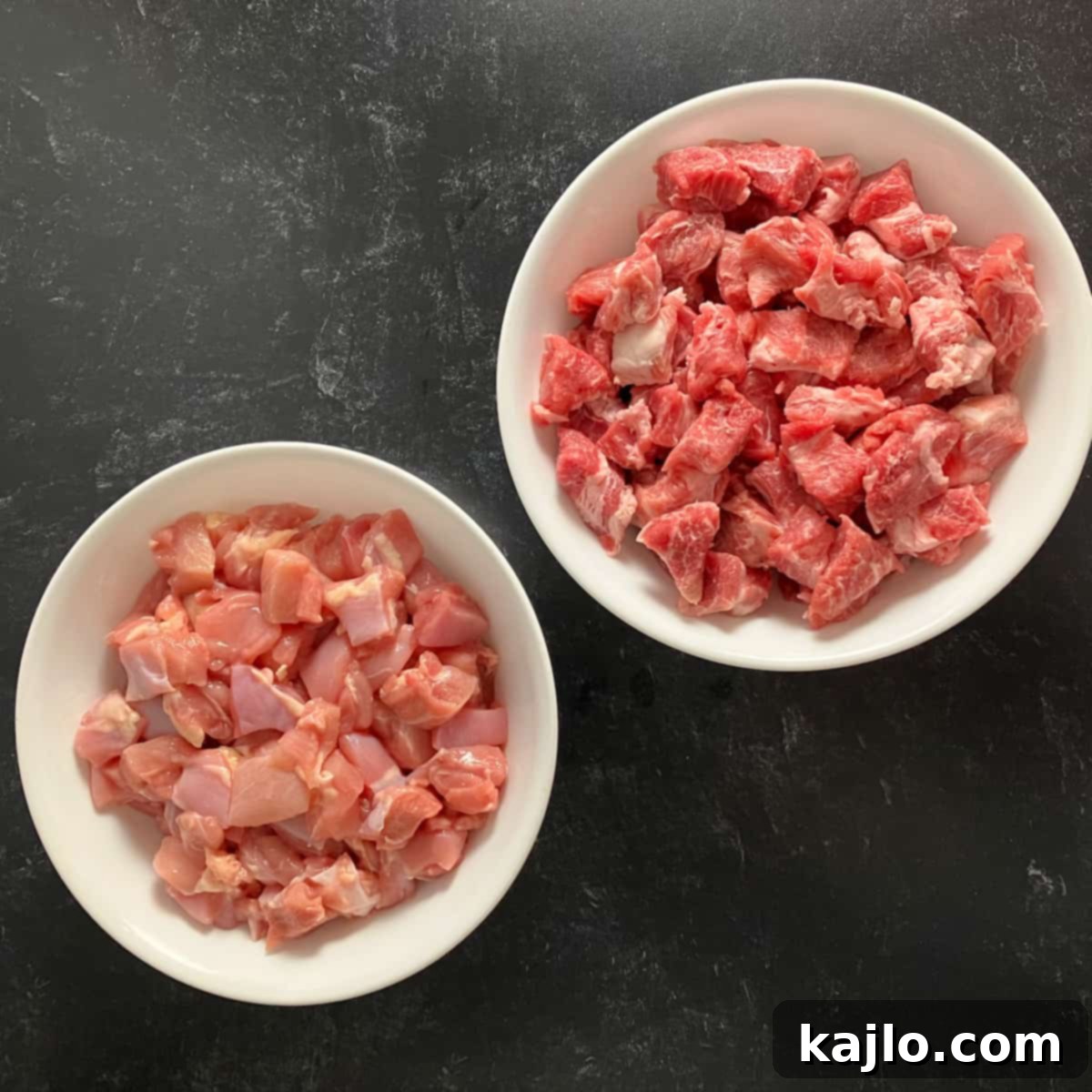
Selecting the Perfect Chile Peppers for Your Fresh Chorizo
The dried chile peppers are undeniably the soul of Mexican chorizo, responsible for its iconic deep red color, intricate flavor profile, and customizable heat. While the convenience of pre-ground chili powder might be tempting, I strongly advocate for embracing the “slow food” ethos by using whole dried chiles in this recipe. This extra step is truly worth it, as it allows you to unlock a far more nuanced and vibrant flavor, giving you precise control over the heat and depth that chili powders simply cannot match.
The choice of chile peppers is a delightful exploration, dependent on the specific heat and flavor characteristics you wish to achieve. For this particular recipe, I chose to lean heavily on guajillo chiles. These peppers are celebrated for their mild-to-medium heat, complex fruitiness, and a subtle tang often compared to green tea. It’s no surprise that, according to reliable culinary sources like Wikipedia, the guajillo chile is the second most commonly used dried chile in authentic Mexican cuisine, highlighting its widespread appreciation and versatility.
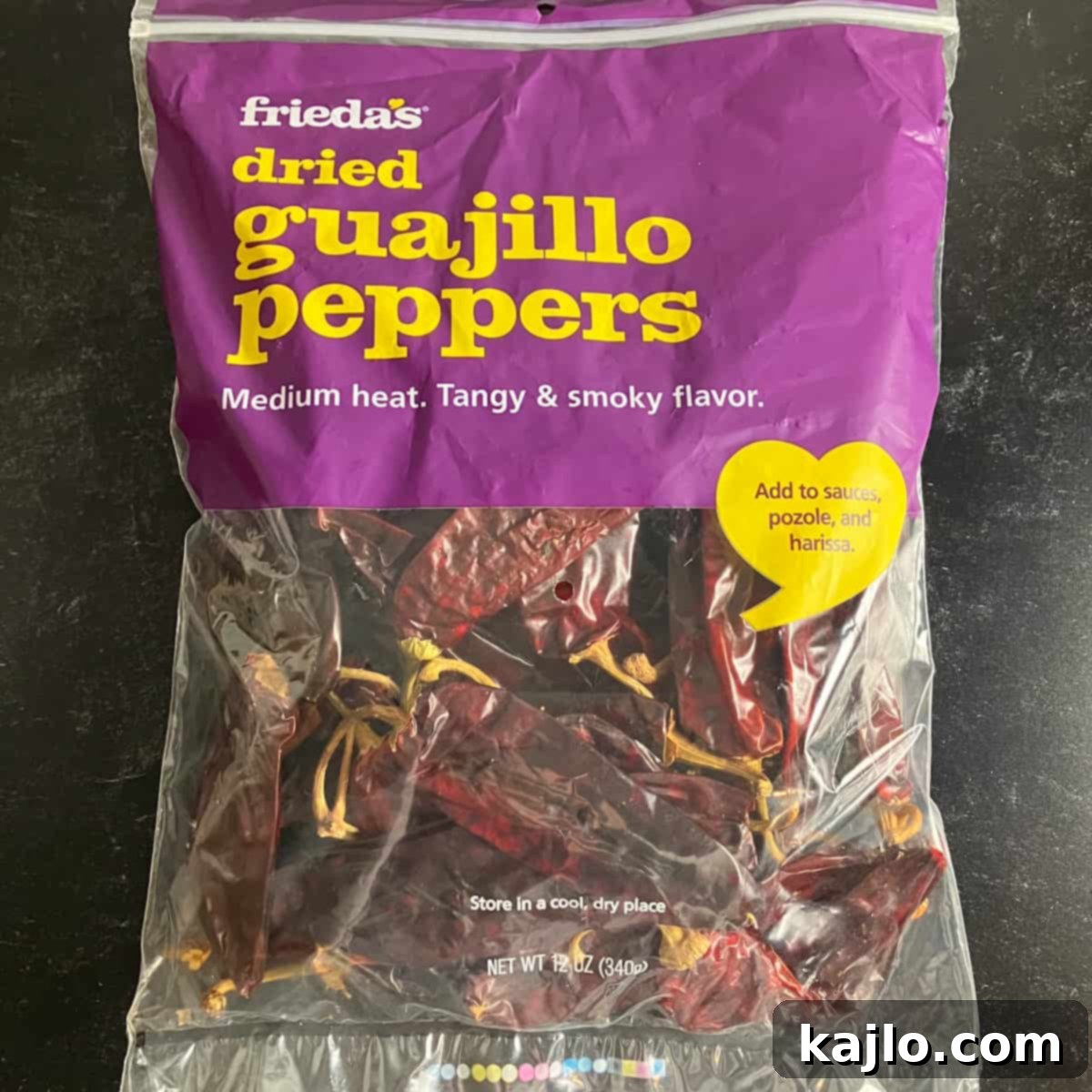
(Can you guess which dried chile pepper holds the top spot? It’s often the Ancho chile!)
Throughout my cooking journey, I’ve encountered and experimented with various chile peppers in Mexican chorizo recipes, each offering a distinct contribution to the final taste:
- Aleppo peppers: Offers a bright, moderate heat with fruity undertones.
- Ancho peppers: Dried poblano peppers that provide a mild, sweet, and smoky flavor, perfect for building a rich base.
- New Mexican chile peppers (e.g., Hatch peppers): Known for their earthy, robust flavor, with heat levels ranging from mild to hot depending on the variety.
- Guajillo peppers: The star of this recipe, contributing mild-medium heat and a distinctive fruity, tangy taste.
- Chiles de Arbol: For those who crave serious heat, these small but mighty peppers deliver a fiery kick. Use them very sparingly!
There is no singular “correct” dried pepper; the best choice is truly subjective and should reflect your personal preference for flavor and heat. Feel confident in adjusting the blend to make the chorizo truly your own.
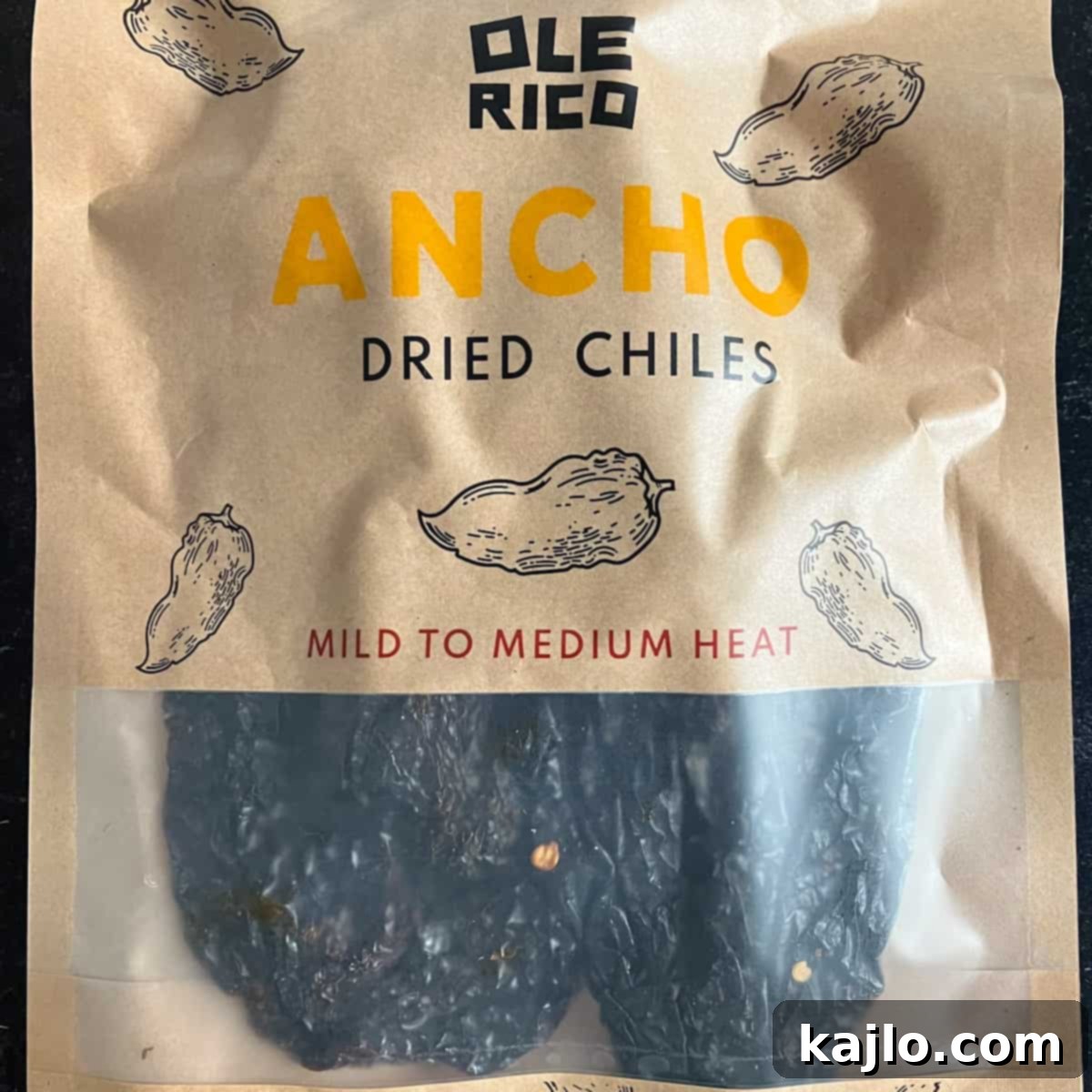
For this recipe, my specific blend includes 6 ancho chiles, 10 guajillo chiles, and 2 japones peppers. The japones peppers provide a subtle yet noticeable additional layer of heat without overwhelming the other flavors. Aim for a total of approximately 16-18 dried chiles to achieve the ideal balance of flavor and spice. This carefully selected combination of dried peppers, alongside the smoked paprika, is precisely what gives your homemade chorizo that exquisite, characteristic deep red color.
As a final touch, while it’s not strictly essential, using Mexican oregano rather than standard Mediterranean oregano can significantly enhance the authenticity of the flavor profile. Mexican oregano possesses a brighter, more citrusy, and earthy note that perfectly complements the other spices in this sausage.
🔥 Step-by-Step Guide: Crafting Your Own Authentic Mexican Chorizo
Embark on the rewarding process of making your very own fresh Mexican chorizo. Follow these detailed, step-by-step instructions to create a truly exceptional and flavorful sausage from scratch:
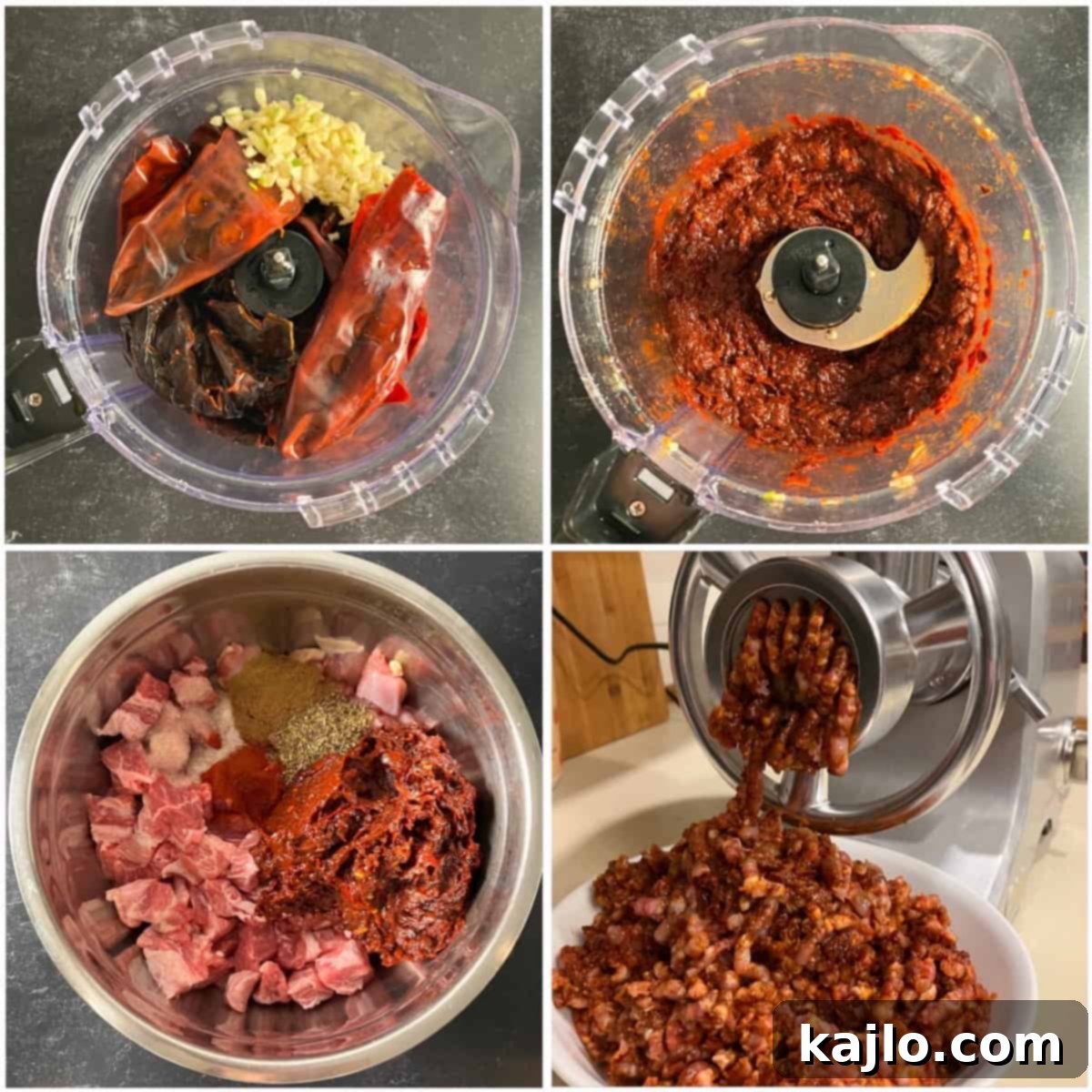
Prepare the Chiles: Begin by removing the tough stems from your dried chiles. Place the chiles in a dry cast-iron skillet over medium heat and toast them for a couple of minutes. This brief heating process helps to awaken and intensify their aromatic flavors. Exercise caution to prevent burning, which can lead to a bitter taste.
Rehydrate the Chiles: Once lightly toasted, transfer the chiles to a heatproof bowl and cover them completely with hot water. Allow them to soak for approximately 30 minutes, or until they become soft and pliable. After rehydration, split each chile open and carefully scrape out and discard most of the seeds. You can leave a few seeds if you desire an extra touch of heat.
Create the Chile Paste: In a food processor, combine the softened chiles, minced garlic, 3 tablespoons of the chile soaking water, and the white vinegar. Blend the mixture until it forms a thick, chunky paste. You may need to stop the food processor occasionally and use a spatula to scrape down the sides, ensuring all ingredients are fully incorporated and the paste is uniform.
Chill and Cut the Meats: For easier and more efficient cutting and grinding, it is essential that your chicken and pork are very cold, ideally almost frozen (maintained at 38-40°F / 3.3-4.4°C). Cut both the boneless, skinless chicken thighs and the pork butt or shoulder into uniform 1-inch (2.54 cm) cubes or smaller.
Combine and Season: In a large mixing bowl, place the cubed chicken and pork. Add the freshly prepared chili pepper paste, salt, dried oregano, ground cumin, and smoked paprika. Stir all the ingredients thoroughly with your hands or a sturdy spoon until everything is evenly combined and the meat is well coated with the spice mixture. Cover the bowl and refrigerate this seasoned meat mixture while you set up your meat grinder.
Grind the Mixture: Attach a coarse grinding plate to your meat grinder. Feed the chilled, seasoned meat mixture slowly through the grinder. A slow and steady pace helps to prevent the grinder from jamming and ensures a consistent texture for your chorizo.
Develop Flavors Overnight: Once the entire mixture has been ground, transfer it back to a clean bowl, cover tightly, and refrigerate it overnight. This resting period is crucial; it allows the vibrant flavors of the chiles, spices, and vinegar to meld, deepen, and fully develop, resulting in a much more flavorful final product.
Final Preparation and Use: After the overnight rest, your homemade chorizo is ready to be cooked or stored! You can use this versatile mixture as a ground meat in your favorite recipes, or you can form it into traditional sausage links if you prefer. If you’re interested in learning how to make sausage links using hog casings, you can find detailed guidance in my homemade sausage with chicken recipe.

Your flavorful homemade chorizo, ready for cooking or freezing.
How to Cook Homemade Chorizo
Cooking your fresh homemade chorizo is wonderfully simple and mirrors the process of cooking any ground meat, such as ground beef or pork. To cook, simply crumble the chorizo into a hot skillet over medium heat. Use a spoon or spatula to break it apart as it cooks and browns. It can be easily integrated into a wide array of your favorite recipes, from breakfast scrambles to savory stews.
Because this specific chorizo recipe includes poultry (chicken thighs), it is absolutely essential to cook it thoroughly until it reaches a minimum safe internal temperature of 165°F (74°C). Always use a reliable meat thermometer to ensure proper doneness and food safety.
🌡️ Optimal Storage Solutions for Your Fresh Homemade Chorizo
This recipe is designed to yield a generous quantity, approximately 4 pounds and 12 ounces (about 2.15 kg) of delicious homemade chorizo. Given this substantial amount, you’ll likely want to store a portion of it for future meals. Proper storage techniques are paramount to maintaining its quality, flavor, and freshness over time.
For immediate use, fresh chorizo can be kept in the refrigerator in an airtight container for up to 3 days. However, for longer preservation, freezing is your best option. I highly recommend using a FoodSaver vacuum sealer. This method allows you to conveniently portion the sausage into 1-pound (454 gram) packages. Vacuum sealing excels at removing air, which is the primary enemy of frozen foods, significantly extending shelf life and effectively preventing freezer burn, thus preserving the chorizo’s texture and flavor for months.
While forming the chorizo into traditional links with casings before freezing is an option, it’s worth considering that fresh Mexican chorizo is almost universally removed from its casing and crumbled during cooking anyway. Therefore, the extra time and effort spent filling casings might be unnecessary, as they often end up discarded. Storing it as a ground meat mixture is typically more practical and just as effective for cooking.
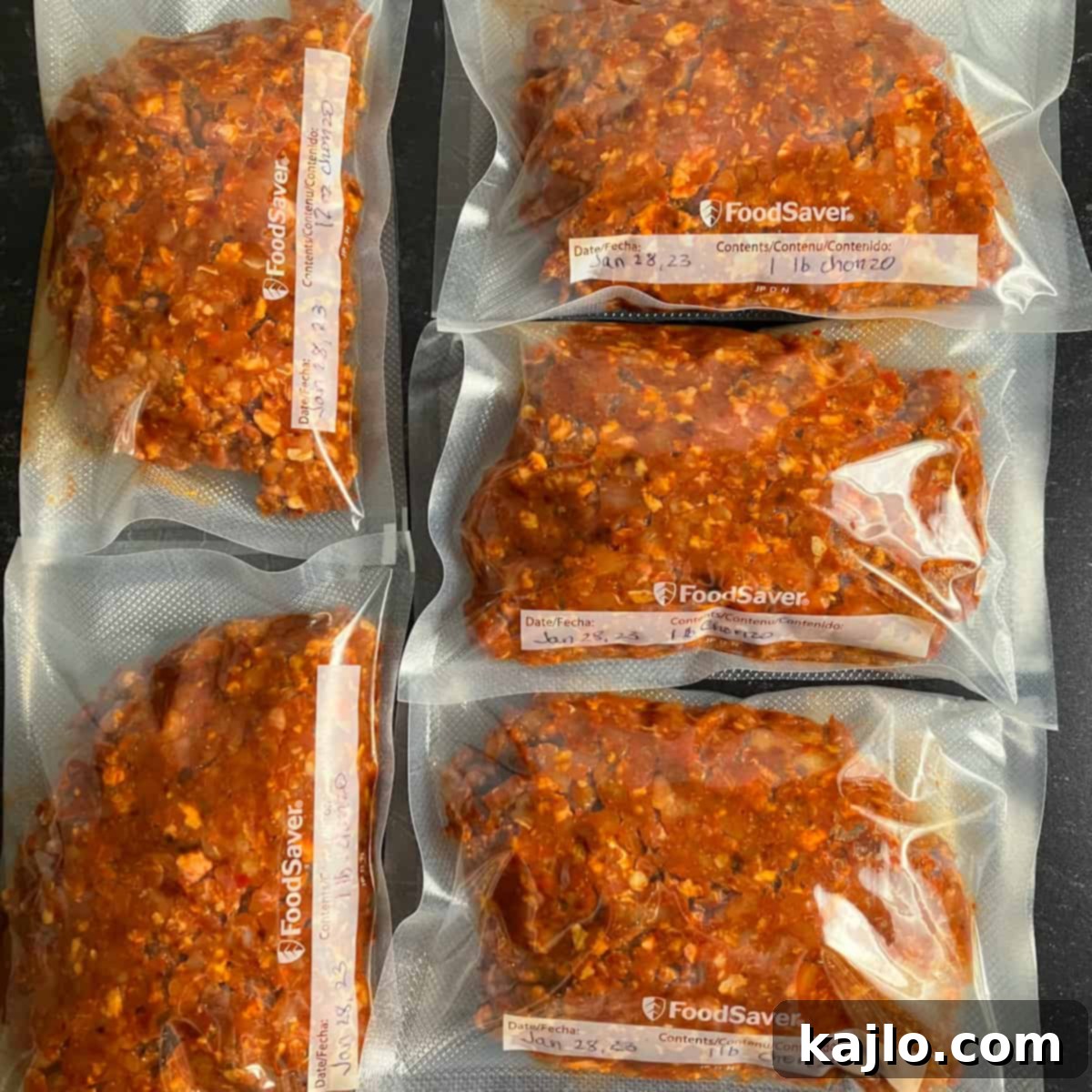
If you don’t own a vacuum sealer, a straightforward, low-tech freezing method involves double-bagging your chorizo in high-quality freezer-safe zip-close bags. To maximize air removal, you can insert a straw into the bag, seal the bag almost completely around the straw, and then suck out as much air as possible before quickly sealing the bag fully. While this method isn’t as efficient as vacuum sealing, it does a commendable job of reducing air exposure and mitigating the risk of freezer burn.
🤔 Expert Tips for Successfully Vacuum Sealing Homemade Chorizo
For those utilizing a FoodSaver vacuum sealer, a few key techniques can make a significant difference in achieving a perfect, long-lasting seal for your homemade chorizo. These tips will help you avoid common sealing issues and ensure optimal preservation:
Maintain Pristine Bag Edges: When you are carefully filling the FoodSaver bags with chorizo, it is absolutely critical to keep the inside edges of the bag opening meticulously clean and dry. Even the slightest residue of oil, grease, or food particles on the area where the bag will seal can prevent the vacuum sealer from forming a strong, airtight bond. A compromised seal can lead to air ingress and eventual freezer burn.
Implement Pre-Freezing: After you’ve filled your bags with chorizo, but before sealing them, place the open bags in the freezer for approximately 1 to 2 hours. This crucial step partially freezes the chorizo, solidifying any moisture or oil within the mixture. By doing so, it prevents these liquids from being drawn up into the sealing area during the vacuuming process, which could otherwise interfere with the seal. A dry, clean sealing surface is essential for success.
Ensure Latch Engagement: Before you initiate the vacuum sealing cycle, always double-check that the “easy lock” latch on your FoodSaver machine is fully engaged and firmly set to the “operate” position. If the latch is not correctly secured, the machine may attempt to seal the bag without first successfully removing all of the air, thereby defeating the primary purpose of vacuum sealing.
Once you get the hang of these simple yet vital steps, vacuum sealing your culinary creations becomes an incredibly easy and efficient method for long-term preservation. It’s a small investment of your time that delivers immense benefits in terms of extended freshness and convenience!

Frequently Asked Questions About Chorizo
Can I Substitute Mexican Chorizo for Spanish Chorizo?
While both are called chorizo, Mexican and Spanish chorizos are quite different. You can substitute one for the other, but be prepared for a significant change in texture and flavor. Spanish chorizo is a cured, firm sausage, often infused with smoky paprika, and typically eaten sliced or added to dishes as a pre-cooked item. Mexican chorizo is a fresh, raw, ground sausage, seasoned with different chiles and vinegar, requiring thorough cooking. If you substitute raw Mexican chorizo for cured Spanish chorizo in a recipe, ensure it is fully cooked to the appropriate internal temperature.
Why is Mexican Chorizo So Red?
The vibrant and appealing red color of Mexican chorizo is primarily attributed to the generous quantities of ground chili peppers (such as ancho and guajillo chiles) and paprika used in its spice blend. These ingredients naturally impart a deep, rich red hue to the sausage, along with their complex flavors.
What Organs Are in Chorizo?
The inclusion of organ meats (also known as offal) in chorizo can vary significantly depending on regional traditions and specific recipes. Some traditional or artisanal chorizos may indeed incorporate organ meats alongside muscle and fat. However, many mass-produced or commercially available chorizos, especially in the United States, are made predominantly from pork muscle and fat, spiced to achieve the desired flavor. If you have specific dietary concerns or preferences regarding organ meats, always review the ingredients list on the product packaging.
Why is There Vinegar in Chorizo?
Vinegar is a crucial ingredient in Mexican chorizo, serving a dual purpose. Firstly, it imparts a distinctive tangy, acidic flavor that beautifully cuts through the richness of the pork and the heat of the chiles, creating a balanced and complex taste profile. Secondly, vinegar traditionally acts as a mild preservative, contributing to the stability and shelf life of the fresh sausage.
Is Carnitas the Same as Chorizo?
No, carnitas and chorizo are entirely distinct Mexican culinary preparations, though both often feature pork. Carnitas refers to pork that has been slow-braised or simmered in lard or oil until it is incredibly tender and succulent, often then shredded and lightly crisped. Chorizo, in contrast, is a highly seasoned, typically ground pork sausage, celebrated for its bold use of chili peppers and spices, and prepared fresh.
How Can You Tell When Chorizo is Done?
When fresh chorizo is fully cooked, it will appear darker in color, browned, and slightly crisper. For absolute food safety, the most reliable method is to use a meat thermometer. If your chorizo is made solely from pork, it should reach an internal temperature of 160°F (71°C). Since this particular recipe includes chicken, it is imperative to cook the chorizo to a minimum internal temperature of 165°F (74°C).
Can I Eat Chorizo Raw?
This homemade chorizo recipe is crafted from raw ground meat and therefore must be thoroughly cooked before it is safe to eat. It is crucial to distinguish this fresh Mexican chorizo from certain types of cured chorizo (often Spanish varieties), which are firm, fermented, and air-dried, making them safe to consume without cooking (source: BBC Good Food). Always ensure you know which type of chorizo you have to guarantee food safety.
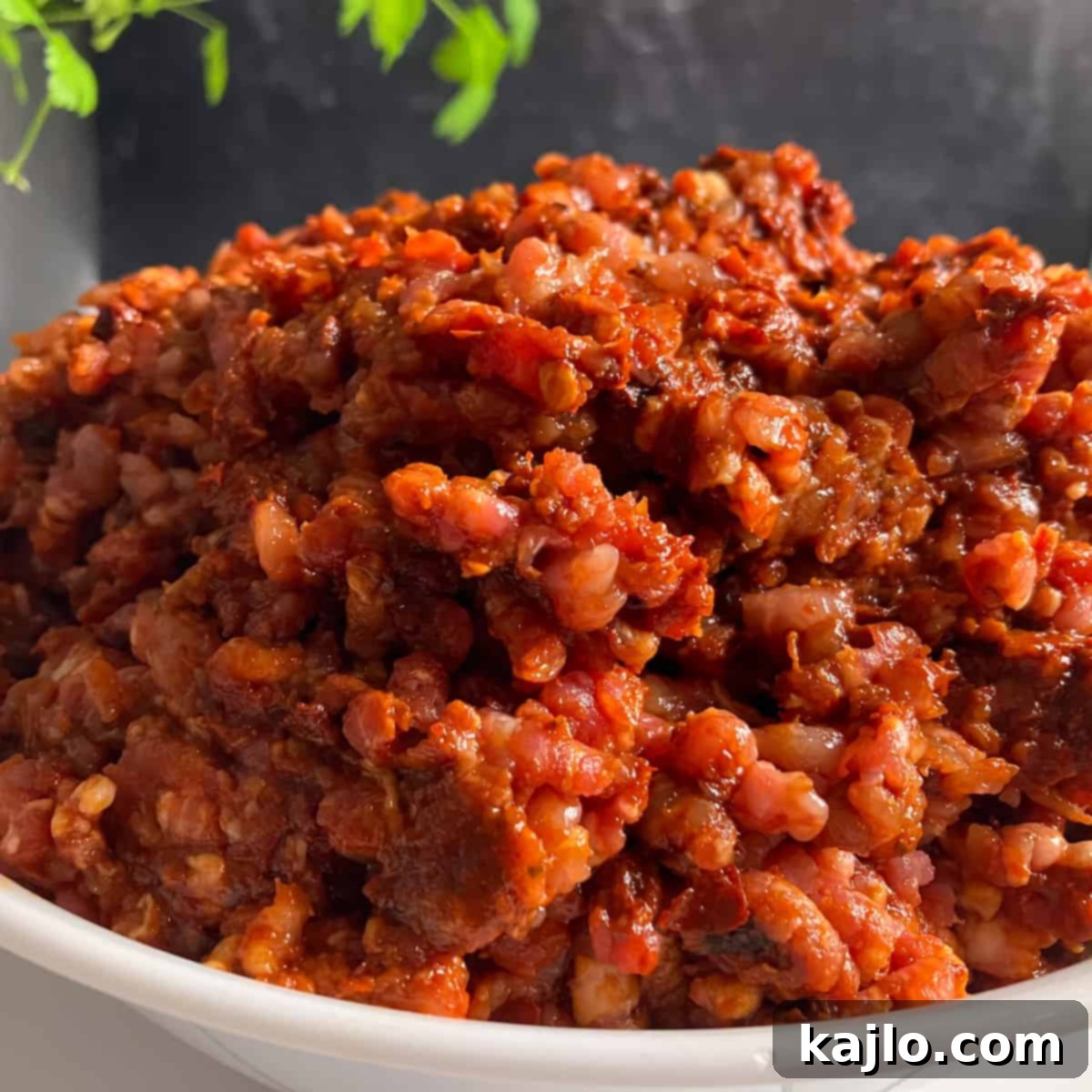
Chorizo Recipe (Fresh, Homemade Mexican Chorizo Sausage!)
Author: Summer Yule
Summary: Master the art of making fresh Mexican-style chorizo from scratch. This vibrant and flavorful sausage uses a blend of dried chile peppers and tangy vinegar, with half pork and half chicken for a delicious, slightly lighter twist!
Print Recipe
Pin Recipe
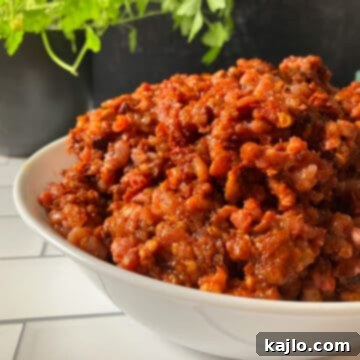
Watch How to Make It!
For a complete visual guide, you can find a video tutorial that accompanies this recipe. Please refer to the original article or search “Homemade Chorizo Recipe Summer Yule” on video platforms for the full walkthrough.
Prep Time: 3 hours
Resting Time: 1 day
Total Time: 1 day 3 hours
Course: Slow Food DIY
Cuisine: Mexican
Servings: 19
Calories: 176 kcal per serving
Ingredients
- 2 lbs pork butt or pork shoulder (907 grams)
- 2 lbs chicken thighs (907 grams; boneless and skinless)
- 2 teaspoons salt
- 6 dried ancho chiles
- 10 dried guajillo chiles
- 2 dried Japones chiles
- 6 tablespoons white vinegar
- 7 cloves garlic, minced
- 1 tablespoon dried oregano (use Mexican oregano, if possible)
- 1 tablespoon ground cumin
- 1 tablespoon smoked paprika
Instructions
- Be sure to read the entire article before you begin this recipe. It contains more detailed information on equipment, tips, and techniques essential for this slow food project.
- Cut the stems off your dried chiles. Heat them gently in a dry cast-iron skillet for a couple of minutes to enhance their flavor and aroma. Be extremely careful not to burn them, as this can introduce bitterness.
- Soak the chiles in hot water for 30 minutes until soft and pliable. After soaking, split them open and discard most of the seeds.
- Place the soaked chiles, minced garlic, 3 tablespoons of the chile soaking water, and the white vinegar into a food processor. Blend this mixture until it forms a chunky paste. You may need to stop the food processor a few times and scrape down the sides with a spatula to ensure an even consistency.
- Keep your meat ingredients very cold, ideally almost frozen (38-40°F / 3.3-4.4°C), for easier cutting and grinding. Cut both the boneless, skinless chicken and pork into 1-inch (2.54 cm) cubes or smaller.
- In a large bowl, combine the cubed chicken, pork, chili pepper paste, salt, dried oregano, ground cumin, and smoked paprika. Stir thoroughly to ensure all ingredients are evenly distributed. Refrigerate this mixture while you prepare your meat grinder.
- Using a meat grinder with a coarse plate, slowly feed the meat mixture through. Grind the mixture coarsely, being careful not to overload the grinder to prevent jamming.
- Refrigerate the freshly ground mixture overnight. This essential step allows the complex flavors to meld and develop, resulting in a significantly more flavorful chorizo.
- At this point, you have two options for storage: you can either double-wrap 1-lb. (454 gram) portions of the chorizo in freezer bags and freeze, or use a vacuum sealer for superior long-term preservation. If you opt for double-wrapping, you can skip the specific vacuum sealing instructions below.
To vacuum seal your chorizo:
- Portion your chorizo into 1-lb (454 gram) amounts and carefully place them into bags designed for your vacuum sealer. It is crucial to keep the opening of the bag clean and dry, free from any food particles or oils, to ensure a proper seal.
- Freeze the filled but unsealed bags for 1-2 hours. This pre-freezing step helps to slightly solidify the chorizo, preventing moisture or oil from interfering with the seal during the vacuuming process.
- Seal your bags according to the directions of your specific vacuum sealer. If you are using a FoodSaver, ensure the “easy lock” latch is fully engaged in the “operate” position for effective vacuuming and sealing.
- Once vacuum sealed, your chorizo packages can be stored in the freezer, ready for you to enjoy delicious fresh chorizo whenever you desire!
Equipment
- Food Processor
- Meat Grinder
- Vacuum Sealer (optional, but highly recommended for freezing)
Notes
💭 Expert Tips from Dietitian Summer Yule
- This recipe yields approximately 4 pounds, 12 ounces (2.15 kg) of chorizo, which translates to about 19 generous 4-ounce (113 gram) servings.
- While traditional chorizo can be rich in fat, incorporating chicken thighs in this recipe offers a delicious and slightly leaner alternative compared to all-pork versions, making it a good choice for those mindful of fat intake.
- To create a well-rounded and more voluminous meal, I recommend balancing the richness of chorizo by serving it with a generous amount of non-starchy vegetables. My popular chorizo stuffed zucchini boats recipe is an excellent example, providing a satisfying and flavorful meal under 600 calories per serving.
- The specific combination of dried chiles used here (ancho, guajillo, and japones) creates a chorizo with a mild to moderate heat level, often suitable for families and even kids. If you prefer a spicier chorizo, feel free to increase the quantity of hotter peppers or incorporate additional fiery chiles like chiles de arbol, adjusting to your preference.
- Please note that the nutrition information provided is an estimate for one serving and can vary based on the specific brands and exact quantities of ingredients used.
Nutrition Info Disclaimer
All recipes on this website may or may not be appropriate for you, depending on your individual medical needs, dietary restrictions, and personal preferences. It is always advisable to consult with a registered dietitian or your physician if you require personalized guidance in determining the most suitable dietary pattern for your health goals.
The nutrition information presented here is an estimate, provided as a courtesy for general reference. Actual nutritional values may differ based on variations in specific brands, ingredient sourcing, and preparation methods. Furthermore, calorie information on food labels can sometimes be inaccurate, so we encourage a balanced approach to tracking and suggest not to overly focus on precise numerical values.
The instruction “to taste” implies adjusting seasonings according to your personal preference. However, always prioritize food safety by adhering to proper cooking temperatures and visual cues for doneness, especially with raw meats. Please do not consume undercooked food.
Nutrition Facts (per serving)
- Calories: 176 kcal
- Carbohydrates: 3.2 g
- Protein: 16.4 g
- Fat: 11 g
- Saturated Fat: 3.8 g
- Sodium: 346.8 mg
- Fiber: 0.9 g
- Vitamin A: 52.9 % DV
- Vitamin C: 2.8 % DV
- Calcium: 1.5 % DV
- Iron: 8 % DV
Keywords: ancho, chorizo, chorizo recipe, gluten-free, guajillo, keto, low-carb, meat grinder, Mexican food, sausage, slow food
Love this recipe? We’d be thrilled if you could leave a comment below! Your feedback means a lot 😊
Explore more recipes! Check out our cookbook: Easy Air Fryer Recipes for One.
Struggling with your air fryer recipes? Don’t let your culinary creations get burnt! Discover how to fix common air fryer issues here!
👨🏻🍳 Explore More Delicious Pork Recipes
If the experience of making your own delicious chorizo has sparked your interest in cooking with pork, you’re in for a treat! Pork is an incredibly versatile and flavorful meat, perfect for a wide range of culinary applications. Here are some more fantastic pork recipes that you might enjoy adding to your repertoire:
- Bacon Wrapped Pork Tenderloin: A succulent and impressive dish perfect for any occasion.
- Chicken Bratwurst with Pork: Another fantastic homemade sausage recipe blending two delicious meats.
- Air Fryer Pork Roast: Achieve a perfectly tender and juicy roast with minimal effort.
- Pork Belly Air Fryer Recipe: Crispy, savory, and utterly irresistible pork belly prepared in your air fryer.
- Boston Butt Pork Roast Recipe: Ideal for slow cooking and creating melt-in-your-mouth pulled pork.
Mastering the art of making this homemade chorizo is a significant step towards becoming a true sausage-making enthusiast. Before you know it, your freezer will be thoughtfully stocked with your own delightful culinary creations, ready to elevate any meal into a gourmet experience!
We’d love to hear from you! Have you ever tried your hand at making chorizo from scratch? If so, what are your personal favorite types of dried peppers to use for achieving that perfect balance of flavor and heat? Share your valuable experiences, tips, and insights in the comments section below!
Join our vibrant community! Don’t miss out on the latest and greatest recipes, culinary tips, and more. Subscribe to our newsletter today, and make sure to follow us on Facebook, Pinterest, Instagram, and YouTube to stay connected and inspired!
